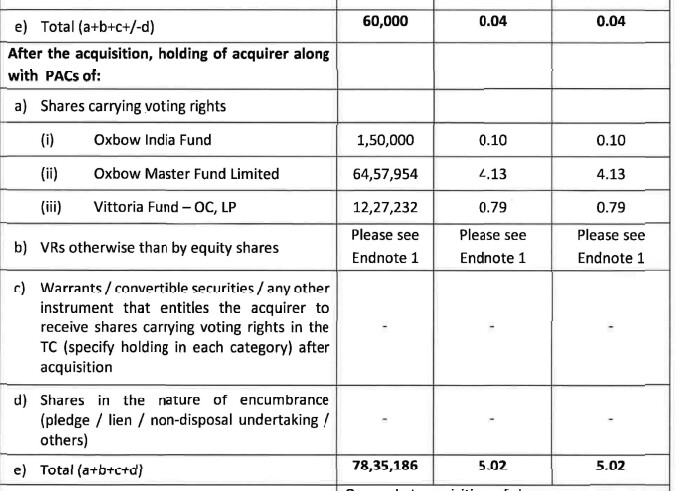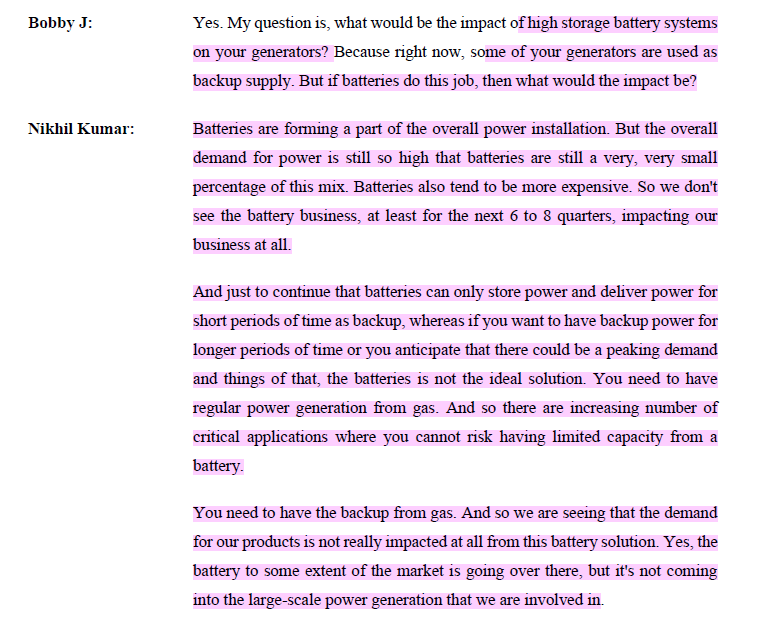Company is confident of achieving 20% CAGR over next 2-3 years. Coincidentally new capacity coming up will able to cater up to 1800 cr revenue. If we assume 16% EBIDTA and 1800 revenue for fy27 - EBIDTA will be 288cr. Assigning a multiple of 15 (5yr median 13.3 and 10yr median 17.1) mkt cap 4600 (EV 4320 + 280 cr cash). Do the current mkt price offer margin of safety?
@karanshah137 @Jay_Shukla Do not share research reports on this forum.
Read the guidelines below.
How do high-storage battery systems impact TD Power Systems’ business?
With advancements in energy storage, large-scale battery systems are increasingly being used for backup power.
Currently, some of TDPS’s generators serve as backup supply solutions. If high-storage batteries take over this role, how could it affect the demand for TDPS’s gas and steam turbine generators?
Would the shift towards battery storage pose a long-term risk to the company’s business, or is the demand for traditional generators secure due to their ability to provide extended backup power and handle peak loads? How does TDPS plan to adapt to this evolving energy landscape?
TD Power Systems’ management is making a strong case for why batteries aren’t an immediate threat to their business. Their key points can be broken down as follows:
1. Power Demand is Still Growing
- Even though battery storage is increasing, the overall demand for electricity is so high that it remains a small fraction of the total energy mix.
- This suggests that there’s still plenty of room for generators, especially for industrial, commercial, and grid-scale applications.
2. Cost Factor of Batteries
- Batteries are expensive—both in terms of upfront costs and long-term lifecycle management.
- Many industries and utilities still find gas and steam turbines more cost-effective for long-duration power supply.
3. Batteries Provide Short-Term Backup, Not Long-Duration Power
- Batteries are great for bridging short gaps, but they aren’t reliable for extended power generation.
- Peaking demand situations and critical applications (hospitals, data centers, military bases, industrial plants) require sustained power, which gas turbine generators provide more effectively.
4. Gas Turbines Are Still Essential for Critical Applications
- Many industries cannot afford power interruptions or capacity limitations that come with battery storage.
- Gas turbine generators are still the most reliable choice for extended backup power and peak demand scenarios.
5. Batteries Aren’t Disrupting Large-Scale Power Generation
- The shift to battery storage is happening mostly at the consumer and decentralized energy level, not in large-scale power generation, where TDPS operates.
- Large utilities and industries are still relying on traditional generators because of their high capacity and reliability.
Sources: Latest Concall
AI Agents + AI Distillation
Enterprise customers are still using models ex of DeepSeek coz of Security (Prompt injection something similar to SQL injection)
Cost is the 2nd consideration - u want to build an agent first and then worry about the optimization
Context : whether Deepseek will change the spending on Datacenter growth and Power capex is needed anymore.
Hyperscalers have said that they might err on the side of over spending Vs crying after few years and ruing the idea of under spending in AI race (especially America)
TD Power caters to Hyperscaler indirectly so the above makes sense too

TD Power buying and Oxbow i guess becomes a SH > 5%
Promotors have been buying recently. Albeit, small amounts.
Have doubled my position in recent days. Will look to add more at current levels.
Expecting robust growth, basis management guidance and market demand.
8.24lac shares bought yesterday by the Vandguard Group. They bought a whole host of companies yesterday.
Came across this article:
Why Gas Pipelines Are the Unsung Heroes of AI Data Center Expansion
Here’s a quick summary of the article (see below):
-
AI data centers are growing rapidly, and with that comes an enormous demand for electricity. While nuclear power is often mentioned as a future solution, natural gas remains the dominant fuel for powering the electrical grid in the U.S. Today, gas pipelines are quietly playing a crucial role in enabling AI expansion.
-
By 2030, AI data centers could require up to 6 billion cubic feet of natural gas per day- up from nearly zero today. This means more reliance on the three key types of gas pipelines: gathering, transmission, and distribution. The densest pipeline networks are found in Texas, Louisiana, and Oklahoma - coincidentally, also the hotspots for massive AI data center projects by Oracle, Meta, Google, and others.
-
Texas, with its extensive gas pipeline infrastructure, is at the forefront, hosting Oracle’s $500 billion AI expansion. Louisiana is seeing Meta’s $10 billion project alongside a $3.2 billion gas power plant, while Oklahoma is attracting billions in investments from Core Scientific and Google.
-
Even the Northeast, though less pipeline-dense, remains a data center powerhouse, with Virginia hosting 70% of the world’s data centers.
As AI continues to expand, natural gas pipelines will remain essential in delivering reliable power, making them the unsung heroes behind the next generation of digital infrastructure.
What does this mean for TD Power?
-
TD Power Systems could benefit from the AI-driven surge in natural gas demand. As AI data centers increasingly rely on natural gas for power, there will be a growing need for gas turbine generators to ensure stable electricity supply and backup power.
-
TD Power, having already secured projects worth $9.28 million last year in Oct for gas turbine generators in the U.S., is well-positioned to tap into this trend.
-
These generators, previously deployed in fracking wells, could now find increasing applications in AI server farms, ensuring continuous power in high-demand environments.
-
With U.S. AI data centers projected to consume up to 6 billion cubic feet of natural gas per day by 2030, the demand for reliable power solutions like TD Power’s generators is likely to grow significantly.
Sources:
They’re running at 100% capacity, 3 shifts. Order pipeline / inflow doesn’t seem to be the concern.
Increase of capacity and improvement of the matrix is what I’m waiting to hear on during the Q4 call.
US has granted Holtec International a critical regulatory approval, allowing the company to transfer small modular reactor technology to India.
I see only 3 names - Holtec India, L&T and Tata here. How is this helping TD in anyway? Or TD is one of the suppliers to Holtec?
It’s positive for the entire sector. SMR’s are not simple and the more tech/IP/support that we receive the better it will be for all the players.
What could be the impact on tariffs on TDPS?
Not much. They do export but mostly to middle east. Don’t think any significant export to US.
Based on the Q3FY25 concall, the impact seems be minimal(8-10% is their revenue from the US) in the short term as their customers are mostly OEMs in US that cannot shift to a new one due to long 2 year qualification cycle thus they should be able to pass this to their customers in the short term. In the long term they do highlighed for some routes through turkey, but this is yet to be seen.
TD Power Credit Rating Update
The short term and long term rating remains stable





